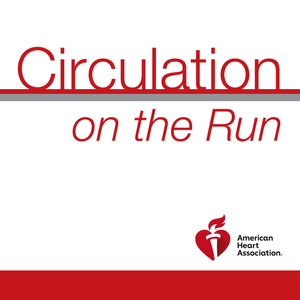
Circulation March 27, 2018 Issue
03/26/18 • 25 min
Dr Carolyn Lam: Welcome to Circulation on the Run, your weekly podcast summary and backstage pass to the journal and its editors. I'm Dr. Carolyn Lam, associate editor from the National Heart Centre and Duke National University of Singapore. Our featured paper this week is an in-depth paper on the cardiovascular and metabolic heterogeneity of obesity, and we will have a discussion with the authors on the clinical challenges, implications for management, and much more coming right up after these summaries.
How does MRI quantification compare with standard Doppler echo approach to identify organic mitral regurgitation and predict adverse outcomes? Well, our first paper this week addresses this question, led by first and corresponding author, Dr. Penicka from the Cardiovascular Center OLV Clinic in Belgium. These authors studied 258 asymptomatic patients with preserved left ventricular ejection fraction and chronic moderate and severe organic mitral regurgitation by echo. All patients underwent MRI to quantify regurgitant volume of this organic mitral regurgitation by subtracting aortic flow volume from the total left ventricular stroke volume. Severe organic mitral regurgitation was defined as a regurgitant volume of greater or equal to 60 milliliters.
The authors found that mean echo-derived regurgitant volume was an average 17 milliliters larger than the MRI-derived regurgitant volume. Concordant grading of organic mitral regurgitation severity with both techniques was observed in 76% of individuals. In the remaining 24% of individuals with discordant findings between the two techniques, this was mainly observed in patients with late systolic, eccentric, or multiple jets.
The MRI-derived regurgitant volume showed the highest discriminative power among all the imaging parameters to predict all cause mortality or its combination with development of indication for mitral valve surgery. Thus, this study demonstrates that MRI-derived assessments of organic mitral regurgitation are clinically accurate to identify asymptomatic patients with severe organic mitral regurgitation and at first outcomes. This may be particularly so when the mitral regurgitation is late systolic, eccentric, or multiple in jets where misclassification may occur with echo-derived approach.
The next study is the first large population-based study to analyze the association between low-dose ionizing radiation from cardiac procedures and incident cancer in adults with congenital heart disease. First author Dr. Cohen, corresponding author Dr. Marelli from McGill University, studied the population from the Quebec Congenital Heart Disease Database and performed a nested case control study comparing cancer cases with controls matched on sex, congenital heart disease severity, birth year, and age. They found that the cumulative incidence of cancer in adults with congenital heart disease between the ages of 18 and 64 years was 15%. The cumulative low-dose ionizing radiation exposure from cardiac procedures was independently associated with incident cancer after adjusting for age, sex, year of birth, congenital heart disease severity and comorbidities.
Results were similar using either the number of procedures or estimates of the effective doses with a possible dose-related response relationship between the low-dose ionizing radiation exposure level and cancer risk. Thus, increasing exposure to low-dose ionizing radiation from cardiac imaging in adults with congenital heart disease raises concerns about life-long risk of malignancy. Confirmation of these findings by prospective studies is needed to reinforce policy recommendations for radiation surveillance in patients with congenital heart disease.
The next study characterizes the long-term dynamics of potassium in heart failure and its associated risk of mortality. First and corresponding author, Dr. Nunez from Hospital Clinic University of Valencia in Spain, evaluated the prognostic implications of long-term longitudinal monitoring and dynamics of serum potassium in a prospective and consecutive cohort of patients following a hospitalization for acute heart failure. In these patients, serum potassium was measured at every physician-patient encounter, including hospital admissions and ambulatory settings.
The authors found that on a continuous scale, the followup trajectory of serum potassium levels independently predicted mortality through a U-shaped association with higher risk at both ends of the distribution, and the same was true using potassium categories. Furthermore, dynamic changes in potassium were independently associated with substantial differences in mortality risk. Persistence of normal potassium levels was linked to a higher risk of death compared to patients who maintained or returned to normal values. Conversely, potassium normalization was independently associated with a lower mortality risk.
These findings ...
Dr Carolyn Lam: Welcome to Circulation on the Run, your weekly podcast summary and backstage pass to the journal and its editors. I'm Dr. Carolyn Lam, associate editor from the National Heart Centre and Duke National University of Singapore. Our featured paper this week is an in-depth paper on the cardiovascular and metabolic heterogeneity of obesity, and we will have a discussion with the authors on the clinical challenges, implications for management, and much more coming right up after these summaries.
How does MRI quantification compare with standard Doppler echo approach to identify organic mitral regurgitation and predict adverse outcomes? Well, our first paper this week addresses this question, led by first and corresponding author, Dr. Penicka from the Cardiovascular Center OLV Clinic in Belgium. These authors studied 258 asymptomatic patients with preserved left ventricular ejection fraction and chronic moderate and severe organic mitral regurgitation by echo. All patients underwent MRI to quantify regurgitant volume of this organic mitral regurgitation by subtracting aortic flow volume from the total left ventricular stroke volume. Severe organic mitral regurgitation was defined as a regurgitant volume of greater or equal to 60 milliliters.
The authors found that mean echo-derived regurgitant volume was an average 17 milliliters larger than the MRI-derived regurgitant volume. Concordant grading of organic mitral regurgitation severity with both techniques was observed in 76% of individuals. In the remaining 24% of individuals with discordant findings between the two techniques, this was mainly observed in patients with late systolic, eccentric, or multiple jets.
The MRI-derived regurgitant volume showed the highest discriminative power among all the imaging parameters to predict all cause mortality or its combination with development of indication for mitral valve surgery. Thus, this study demonstrates that MRI-derived assessments of organic mitral regurgitation are clinically accurate to identify asymptomatic patients with severe organic mitral regurgitation and at first outcomes. This may be particularly so when the mitral regurgitation is late systolic, eccentric, or multiple in jets where misclassification may occur with echo-derived approach.
The next study is the first large population-based study to analyze the association between low-dose ionizing radiation from cardiac procedures and incident cancer in adults with congenital heart disease. First author Dr. Cohen, corresponding author Dr. Marelli from McGill University, studied the population from the Quebec Congenital Heart Disease Database and performed a nested case control study comparing cancer cases with controls matched on sex, congenital heart disease severity, birth year, and age. They found that the cumulative incidence of cancer in adults with congenital heart disease between the ages of 18 and 64 years was 15%. The cumulative low-dose ionizing radiation exposure from cardiac procedures was independently associated with incident cancer after adjusting for age, sex, year of birth, congenital heart disease severity and comorbidities.
Results were similar using either the number of procedures or estimates of the effective doses with a possible dose-related response relationship between the low-dose ionizing radiation exposure level and cancer risk. Thus, increasing exposure to low-dose ionizing radiation from cardiac imaging in adults with congenital heart disease raises concerns about life-long risk of malignancy. Confirmation of these findings by prospective studies is needed to reinforce policy recommendations for radiation surveillance in patients with congenital heart disease.
The next study characterizes the long-term dynamics of potassium in heart failure and its associated risk of mortality. First and corresponding author, Dr. Nunez from Hospital Clinic University of Valencia in Spain, evaluated the prognostic implications of long-term longitudinal monitoring and dynamics of serum potassium in a prospective and consecutive cohort of patients following a hospitalization for acute heart failure. In these patients, serum potassium was measured at every physician-patient encounter, including hospital admissions and ambulatory settings.
The authors found that on a continuous scale, the followup trajectory of serum potassium levels independently predicted mortality through a U-shaped association with higher risk at both ends of the distribution, and the same was true using potassium categories. Furthermore, dynamic changes in potassium were independently associated with substantial differences in mortality risk. Persistence of normal potassium levels was linked to a higher risk of death compared to patients who maintained or returned to normal values. Conversely, potassium normalization was independently associated with a lower mortality risk.
These findings ...
Previous Episode

Circulation March 20, 2018 Issue
Dr Carolyn Lam: Welcome to Circulation on the Run, your weekly podcast summary and backstage pass to the journal and its editors. I'm Dr. Carolyn Lam, Associate Editor from the National Heart Centre and Duke National University of Singapore. How common is perioperative myocardial injury after non-cardiac surgery, and what is its significance? A very important question and a very important feature discussion coming right up after these summaries.
Our first original paper this week tells us that risk assessment using only non-laboratory based risk factors may be a useful alternative in the absence of informational lipids, in predicting adolescents at risk of developing pre-clinical atherosclerosis.
First and corresponding author, Dr. Koskinen from University of Turku Finland and colleagues, studied almost 2,900 participants, age 12-18 years, from four longitudinal cohort studies from the United States, Australia, and Finland, and followed these adolescents into adulthood. When carotid intima media thickness was measured, a mean followup of 23 years later. Non-laboratory based risk factors such as age, blood pressure, body mass index, and lipids measured in adolescence, independently predicted high carotid intima media thickness in young adulthood. The addition of lipid measurements to these traditional clinic based risk factor assessments provided a statistically significant but clinically modest improvement on adolescent prediction of high carotid intima media thickness in adulthood.
The next study demonstrates the feasibility of large scale aptamer multiplexing at a level that has not previously been reported and with sample proof that greatly exceeds other existing proteomic methods.
Now, like antibodies, DNA aptamers can be generated as affinity reagents for proteins. Emerging data suggests that they can be used to measure blood protein levels in clinical cohorts. However, the technology has, to date, remained in its infancy. In today's study, co-first authors, Dr. Jacob and Dr. Ngo, co-corresponding authors, Dr. Jennings and Gerszten, from Beth Israel Deaconess Medical Center in Boston, tested the scalability of a highly multiplexed expended proteomic technique that uses single stranded DNA aptamers to assay human proteins with a markedly expended platform containing approximately 5,000 aptamers targeting a far broader range of analytes than previously examined using this technology. They applied the platform to a cohort of individuals undergoing septal alcohol ablation for hypertrophic cardiomyopathy, using this as a human model of planned myocardial injury.
Now, in addition to confirming findings from prior studies, they identified nearly 150 additional putative markers of myocardial injury. Thus, these findings suggest that the expanded aptamer based proteomic platform may provide a unique opportunity for biomarker and pathway discovery following myocardial injury.
The next study addresses the potential long-term effects of low LDL cholesterol on neurocognitive impairment and decline. This has been a concern with pharmacologic PCSK9 inhibition. The first author, Dr. Mefford, corresponding author, Dr. Levitan from University of Alabama at Birmingham, investigated the association between PCSK9 loss of function variants and neurocognitive impairment and decline in the regards study.
In this general population sample of African American adults, they found no association between PCSK9 loss of function variants and neurocognitive impairment or longitudinal neurocognitive decline. There was also no association between lower LDL cholesterol levels and neurocognitive impairment or decline during follow-up.
The study, therefore, provides evidence in a contemporary population that PCSK9 loss of function variants and resulting lifelong exposure to low LDL cholesterol levels are not associated neurocognitive impairment or decline.
The final study explores long-term outcomes in patients with Type 2 myocardial infarction and injury. First and corresponding author, Dr. Chapman from University of Edinburgh and his colleagues identified more than 2,000 consecutive patients with elevated cardiac troponin I concentrations at a tertiary cardiac center. All diagnoses were adjudicated as per the universal definition of myocardial infarction. They found that at five years, all cause death rates were higher in those with type 2 myocardial infarction or injury compared with type 1.
Although the majority of excess deaths with type 2 myocardial infarction or injury were due to non-cardiovascular causes, the observed crude major at-risk cardiovascular events are MACE rates were similar between groups. Coronary heart disease wan an independent predictor of MACE in those with type 2 myocardial infarction or injury. Thus, despite an excess in non-cardiovascular death, patients with type 2 myocardial infarction or injury have a similar crude rate ...
Next Episode

Circulation April 3, 2018 Issue
Dr Carolyn Lam: Welcome to Circulation on the Run, your weekly podcast summary and backstage pass to the journal and its editors. I'm Dr. Carolyn Lam, Associate Editor from the National Heart Center and Duke National University of Singapore.
Today's feature paper is about statins, and it's the first population-based study to show a dose-dependent benefit on amputation and survival in peripheral artery disease. Very important data and a very important discussion coming right up after these summaries.
The first original paper this week indicates for the first time that the natural history of coronary stenosis is better predicted by physiologic information by FFR, or fractional flow reserve, than by anatomic information from angiography. First author, Dr. Ciccarelli, corresponding author, Dr. DeBruyne, from OLV Hospital in Belgium compared the values of angiographic diameter stenosis and of fractional flow reserve in predicting the natural history among 607 patients from the FAME 2 trial who had documented stable coronary disease and in whom no revascularization was performed. The primary end point was defined as vessel oriented clinical end point at two years, and this was a composite of prospectively adjudicated cardiac death, vessel-related myocardial infarction, vessel-related urgent and non-urgent revascularization.
The overall results showed that FFR predicted the natural history better than diameter stenosis. In addition, among the stenosis with mismatch between diameter stenosis and FFR, more than half had a low FFR in the presence of an angiographically mild stenosis and the rate of primary outcome was higher in those with reduced FFR regardless of whether diameter stenosis was significant or not. The take-home message is, therefore, that measurements of FFR should be considered not only an angiographically intermediate stenosis but also perhaps a mild or severe stenosis by visual evaluation.
The next study provides population-based data on cardiovascular outcomes and risks after initiation of a sodium glucose cotransporter-2 inhibitor, or SGLT2 inhibitor. First and corresponding author, Dr. Udell, from University of Toronto, and his colleagues, performed population-based cohort study among type 2 diabetes patient with established cardiovascular disease and newly initiated on antihyperglycemic agents within the US Department of Defense Military Health System between 2013 and 2016. After propensity matching, more than 25,250 patients were followed for a median of 1.6 years. Initiation of SGLT2 inhibitors was associated with a lower all-cause mortality, lower hospitalization for heart failure events, lower major adverse cardiovascular events, but higher below-knee amputation risk. Findings underscore the potential benefits and risks to be aware of when initiating SGLT2 inhibitors. Importantly, it remains unclear whether the risk of below-knee amputation extends across a class of medications as the study was not powered to make comparisons among individual treatments.
The next paper reports results of the redefined trial, which is the first trial to study the effects of renin-angiotensin-aldosterone system inhibitors in adults with tetrology of Fallot and mild right ventricular dysfunction in the absence of severe valvular lesions. First author, Dr. Bokma, and corresponding author, Dr. Bouma from Academic Medical Center Amsterdam, and their colleagues, studied 95 patients in the redefined trial and found that 150 mg of losartan daily did not significantly improve the primary outcome of right ventricular ejection fraction change compared to placebo. There were no significant treatment effects on secondary outcomes of left ventricular ejection fraction, peak aerobic exercise capacity or NT-proBNP. However, in a post hoc analysis, losartan was associated with improved right ventricular ejection fraction in a subgroup of 30 patients with nonrestrictive right ventricles and incomplete remodeling. The conclusion is, therefore, that losartan had no significant effect on right ventricular dysfunction or secondary outcome parameters in repaired tetralogy of Fallot. Future larger studies may determine whether there might be a role for losartan in specific vulnerable subgroups.
The final study reinforces that vesicle trafficking plays an essential role in the signal regulation of pathologic hypertrophy and identifies a novel potential target in this process. This novel target is the transmembrane BAX inhibitor motif containing 1, or TMBIM1. First author, Dr. Deng, corresponding author, Dr. Li, from Wuhan University in China, and their colleagues, found that TMBIM1 expression levels were substantially decreased in both clinical and experimental hypertrophic hearts. Mechanistically, TMBIM1 interacted directly with tumor susceptibility gene 101 and accelerated the formation of multivesicular bodies to degrade activated toll-like receptor 4. Toll-like receptor 4 d...
If you like this episode you’ll love
Episode Comments
Generate a badge
Get a badge for your website that links back to this episode
<a href="https://goodpods.com/podcasts/circulation-on-the-run-255644/circulation-march-27-2018-issue-29730618"> <img src="https://storage.googleapis.com/goodpods-images-bucket/badges/generic-badge-1.svg" alt="listen to circulation march 27, 2018 issue on goodpods" style="width: 225px" /> </a>
Copy




